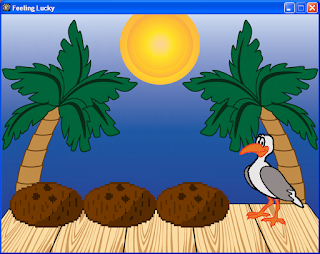Now time to do the post-mortem!
This game went surprisingly smoothly, save for a few particularly bone-headed moments and a LOT of frustration getting cxfreeze to work properly (seriously, how can you forget to include something that is IN the include call?) We started out with a long idea session that seemed to center around an idea called "Grammar Nazi." Thankfully, that idea didn't hold enough interest to develop and we settled on the trope of abducting royalty as a dragon. I even got ambitious and got the framework for the game ready the first evening. I went home to bed happy, thinking that I had gotten so much done already.
The next day I got into a HUGE memory leak due to my framework not properly closing out when switching between screens. I spent an hour working on getting that migrated over to objects instead and then implemented the item system. At this point, we had an artist that we were supposed to be sharing with another group (thanks again, Tamara!) and things felt good. We even had a few teenagers helping out with the audio portions. I brought in my home-made sword and so did Brian, so we had props for making convincing sound effects for the game as well. As the day dragged on into the evening, things started going sideways.
Our awesome artist couldn't work with us anymore, since she had prior plans. That left us with about 3/4 of the assets we needed and no one to do the rest. I was looking at doing artwork for some time, so I stepped up and started jamming on the art, leaving the code work to Brian. The guys working on audio were not really into it and started messing around with two shiny swords outside. They claimed they were making sound assets, and they did, but their methodology could have used some... work. After about an hour (maybe more, maybe less. I was lost in artwork), they came back in with dinged swords, cracked chain maille and apologies. Apparently, they used the equipment improperly and caused quite a bit of damage. I was so engrossed in the artwork, I forgot the first rule of teenagers: Never give them dangerous things without supervision. I went home that night with a rather sour taste in my mouth.
The next morning, I got in and attempted to start working on art again. I was immediately foiled by a broken tablet pen. Just as I was getting comfortable with it, too. I had to go grab a mouse to work with and got back to art. Thankfully, the rest of the development process went smoothly.
When we went to package the game up, we had troubles with it packing up nicely for mac. We spent an hour working on it, but to no avail. I was getting tired, so I packaged up a Windows build, tested it and went to bed. Apparently I should have tested it on another computer without python installed, since I looked at the progress of voting and found a long list of "Broken game!" comments on the site. I just figured out that cx_freeze was not including pygame._view in the build, rendering it useless. D'oh! At least now the game is playable.
Ok, time for the Good, the Bad, the Ugly:
The Good
- We released a game!
- I got to do some artwork
- Scope Creep wasn't really an issue
- Execution was very close to the original Idea
The Bad
- Artist had to duck out
- Bad build on layman PCs
- Broken equipment (tablet pen, swords)
- Animation had to get cut back for the Nobility
The Ugly
- Broken chain maille
- A week's worth of "Broken Game!" comments on the Ludum Dare website











